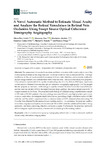Mostrar el registro sencillo del ítem
A Novel Automatic Method to Estimate Visual Acuity and Analyze the Retinal Vasculature in Retinal Vein Occlusion Using Swept Source Optical Coherence Tomography Angiography
| dc.contributor.author | Díez Sotelo, Marta | |
| dc.contributor.author | Díaz González, Macarena | |
| dc.contributor.author | Abraldes, Maximino | |
| dc.contributor.author | Gómez-Ulla, Francisco | |
| dc.contributor.author | Penedo, Manuel | |
| dc.contributor.author | Ortega Hortas, Marcos | |
| dc.date.accessioned | 2019-10-04T14:40:55Z | |
| dc.date.available | 2019-10-04T14:40:55Z | |
| dc.date.issued | 2019-09-20 | |
| dc.identifier.citation | Díez-Sotelo, M.; Díaz, M.; Abraldes, M.; Gómez-Ulla, F.; G. Penedo, M.; Ortega, M. A Novel Automatic Method to Estimate Visual Acuity and Analyze the Retinal Vasculature in Retinal Vein Occlusion Using Swept Source Optical Coherence Tomography Angiography. J. Clin. Med. 2019, 8, 1515. | es_ES |
| dc.identifier.issn | 2077-0383 | |
| dc.identifier.uri | http://hdl.handle.net/2183/24022 | |
| dc.description.abstract | [Abstract] The assessment of vascular biomarkers and their correlation with visual acuity is one of the most important issues in the diagnosis and follow-up of retinal vein occlusions (RVOs). The high workloads of clinical practice make it necessary to have a fast, objective, and automatic method to analyze image features and correlate them with visual function. The aim of this study is to propose a fully automatic system which is capable of estimating visual acuity (VA) in RVO eyes, based only on information obtained from macular optical coherence tomography angiography (OCTA) images. We also propose an automatic methodology to rapidly measure the foveal avascular zone (FAZ) area and the vascular density (VD) in the superficial and deep capillary plexuses in swept-source OCTA images centered on the fovea. The proposed methodology is validated using a representative sample of 133 visits of 50 RVO patients. Our methodology estimates VA with very high precision and is even more accurate when we integrate depth information, providing a high correlation index of 0.869 with the real VA, which outperforms the correlation index of 0.855 obtained when estimating VA from the data obtained by the semiautomatic existing method. In conclusion, the proposed method is the first computational system able to estimate VA in RVO, with the additional benefits of being automatic, less time-consuming, objective and more accurate. Furthermore, the proposed method is able to integrate depth information, a feature which is lacking in the existing method. | es_ES |
| dc.description.sponsorship | Mutua Madrileña; 2017/365. | es_ES |
| dc.language.iso | eng | es_ES |
| dc.publisher | MDPI AG | es_ES |
| dc.relation.uri | https://doi.org/10.3390/jcm8101515 | es_ES |
| dc.rights | Atribución 3.0 España | es_ES |
| dc.rights.uri | http://creativecommons.org/licenses/by/3.0/es/ | * |
| dc.subject | Optical coherence tomography angiography | es_ES |
| dc.subject | Retinal vein occlusion | es_ES |
| dc.subject | Automatic method | es_ES |
| dc.subject | Visual acuity estimation | es_ES |
| dc.subject | Imaging retina | es_ES |
| dc.title | A Novel Automatic Method to Estimate Visual Acuity and Analyze the Retinal Vasculature in Retinal Vein Occlusion Using Swept Source Optical Coherence Tomography Angiography | es_ES |
| dc.type | info:eu-repo/semantics/article | es_ES |
| dc.rights.access | info:eu-repo/semantics/openAccess | es_ES |
| UDC.journalTitle | Journal of Clinical Medicine | es_ES |
| UDC.volume | 8 | es_ES |
| UDC.issue | 10 | es_ES |
| UDC.startPage | 1515 | es_ES |
| dc.identifier.doi | 10.3390/jcm8101515 |
Ficheros en el ítem
Este ítem aparece en la(s) siguiente(s) colección(ones)
-
GI-VARPA - Artigos [59]






